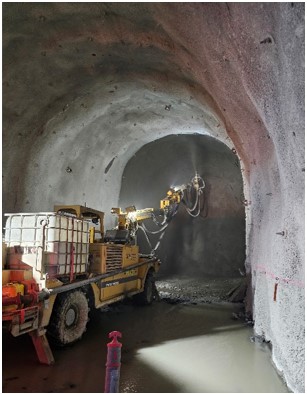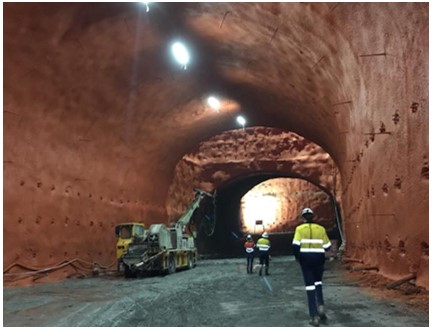Over the last 20 years shotcrete has become the most widely used method of ground support in underground construction in Australia. The reason for this widespread application is the adaptability and effectiveness of shotcrete for both immediate and long-term ground support.
 Shotcrete is frequently used for temporary support as tunnel excavation is advanced because no other form of support can lock the surface of ground together and prevent it from unravelling in the manner that is possible using shotcrete. Its long-term durability is also outstanding, making it effective as a means of permanent support as well as temporary support. This means that many tunnel linings consist of an initial temporary lining over which a thicker permanent lining is directly sprayed. Alternately, a cast-in-place lining may be cast against the surface of the initial temporary shotcrete lining. Both methods of tunnel lining construction have been used in Australia.
Shotcrete is frequently used for temporary support as tunnel excavation is advanced because no other form of support can lock the surface of ground together and prevent it from unravelling in the manner that is possible using shotcrete. Its long-term durability is also outstanding, making it effective as a means of permanent support as well as temporary support. This means that many tunnel linings consist of an initial temporary lining over which a thicker permanent lining is directly sprayed. Alternately, a cast-in-place lining may be cast against the surface of the initial temporary shotcrete lining. Both methods of tunnel lining construction have been used in Australia.
Design of a tunnel needs to consider durability, water resistance, fire resistance, seismic effects, other internal loads and maintainability. The required design life of most tunnel is around 100-120 years.
Design for strength and serviceability of tunnel is more complex than for above ground structures, because the load arising from the ground, and support of the ground associated with the shotcrete lining, are dependent on each other.
Safety in the context of designing tunnels is important. Design should include identifying any possible risks and manage those to be as minimal as possible before construction and operation begins.
Shotcrete has a long history of being applied in tunnelling and underground construction due to its ability to support an excavation in combination with rock reinforcement quickly and reliably. Shotcreting has become one of the most effective ground support tools in tunnelling and mining applications.
It has been recognised that shotcrete provides practical ground support with a higher level of safety for installation and personnel entry than previous support systems predominantly relying on mesh and bolts. The development of hydroscaling helped to improve the bond between shotcrete and rock, and the addition of fibres to the shotcrete mixes has made mesh largely redundant.
Initially, shotcrete was only used as a temporary support as shotcrete linings were not deemed durable due to their sprayed and layered application. With the advances in mix designs, shotcrete technology and quality control, permanent shotcrete linings have become widely accepted.
The lining design is typically carried out following the Australian Standards AS 3600 and AS 5100, supplemented by other relevant codes of practice and guidelines for the design of unreinforced and fibre-reinforced shotcrete. Several documents exist that guide the design of tunnel shotcrete linings in a variety of ground conditions, with a few listed in the following:
- ACI 506.2-13(18) - Specification for Shotcrete
- ACI 506R-16 – Guide to Shotcrete
- ACI 544.4R-18 - Guide to Design with Fiber-Reinforced Concrete
- AFTES – Recommendations for the Design of Sprayed Concrete in Underground Support, Association Francaise des Tunnels et de I’Espace Souterrain, 2000.
- AGS guideline - Austrian Geotechnical Society, Guideline for geotechnical design of underground structures with conventional excavation, 2010
- BTS Specification - Specification for Tunnelling. British Tunnelling Society and the Institution of Civil Engineers, Third Edition, pp200, Thomas Telford, London, 2010.
- Concrete Institute of Australia/Australia Shotcrete Societe (2020) – Recommend Practice: Shotcreting in Australia, Third Edition
- DAfStb Guideline - DAfStb German Committee for Structural Concrete - Commentary on the DAfStb Guideline “Steel Fibre Reinforced Concrete”, 2015 (DAfStb-Richtlinie Stahlfaserbeton, Deutscher Ausschuss für Stahlbeton).
- DBV – Guide to good practice –Design principles of steel fibre reinforced concrete for tunnelling works, German Society for Concrete and Construction Technology, 10/ 2001.
- Fib MC2010 – Model Code for Concrete Structures (2010).
- Hoek, E., Carranza-Torres, C., Diederichs, M., and Corkum, B., "Integration of geotechnical and structural design in tunneling", Proceedings University of Minnesota 56th Annual Geotechnical Engineering Conference, Minneapolis, 29 Feb 2008, pp1-53.
- ICE Design and Practice Guides: Sprayed Concrete Linings (NATM) for Tunnels in Soft Ground, Institution of Civil Engineers, London, 1996.
- John, M. & Mattle, B., "Shotcrete Lining Design, Factors of Influence", RETC Proceedings, pp726-734, 2003.
- RILEM guidelines - RILEM TC 162-TDF: 'Test and design methods for steel fibre reinforced concrete, σ-ϵ design method', as published by Materials and Structures / Matériaux et Constructions, Vol. 36, October 2003, pp. 560-567.
- Technical Report No. 63 Guidance for the Design of Steel Fibre Reinforced Concrete, The Concrete Society, United Kingdom, 2007
- Windsor, CR "Shotcrete Rock Support in Australian Mines: Curing and Thickness", Surface Support in Mining, Australian Centre for Geomechanics, 2004.
The requirements on the mixes, particularly for compressive strength, flexural strength and toughness, need to be specified in the design and demonstrated through testing. Strength development and fibre content must be selected to ensure a ductile rather than brittle failure mode over the structure's design life. In contrast, adequate early strength for personnel entry must be achieved within minimal time. Shrinkage and creep also need to be accounted for. Additionally, the local availability and selection of aggregates, cementitious materials, admixtures, and the potential for the use of appropriate waste materials such as sand, tailings, and crushed rock should be considered, with all of these parameters affecting the shotcrete performance.
Permanent shotcrete linings need, equally to traditional final concrete linings, to be designed for serviceability, durability, fire resistance and any other project-specific requirements, including environmental exposure or the provision for particular load cases. The shotcrete mixes need to be devised to meet the relevant requirements.
Furthermore, for an effective shotcrete lining design and application, the following key factors require consideration:
- Ground conditions, including locked-in rock stresses,
- Hydrogeological conditions and water pressure onto the lining,
- Deformation and settlement,
- Interaction with other ground support elements,
- Drainage and waterproofing requirements,
- Substrate preparation before shotcrete application,
- Surface finish requirements.
 Traditionally, primary tunnel shotcrete linings have been used with a sheet waterproofing membrane and a cast in-situ secondary lining. While not impossible, shotcreting against sheet membranes requires reinforcement and strict application process control to achieve a quality product, as shotcrete does not stick to such membranes.
Traditionally, primary tunnel shotcrete linings have been used with a sheet waterproofing membrane and a cast in-situ secondary lining. While not impossible, shotcreting against sheet membranes requires reinforcement and strict application process control to achieve a quality product, as shotcrete does not stick to such membranes.
In the last 15 years, spray-applied waterproofing membranes have gained broader acceptance in tunnelling applications. Such waterproofing products bond to the inner and outer tunnel linings, meaning the secondary inner lining can be a shotcrete lining. The two shotcrete linings, with the membrane in between, create a sandwich structure that acts somewhat as a composite lining. The shotcrete performance, design, construction and testing requirements for this approach differ from those applied when using traditional sheet membranes, which must be considered when selecting this method.
For any further details or information on the shotcrete application in underground applications, please contact the AuSS. We are happy to provide you with further guidance on your specific requests.
For more information, see Australian Tunnelling Society
Also see: Concrete Institute of Australia - Shotcreting in Australia


